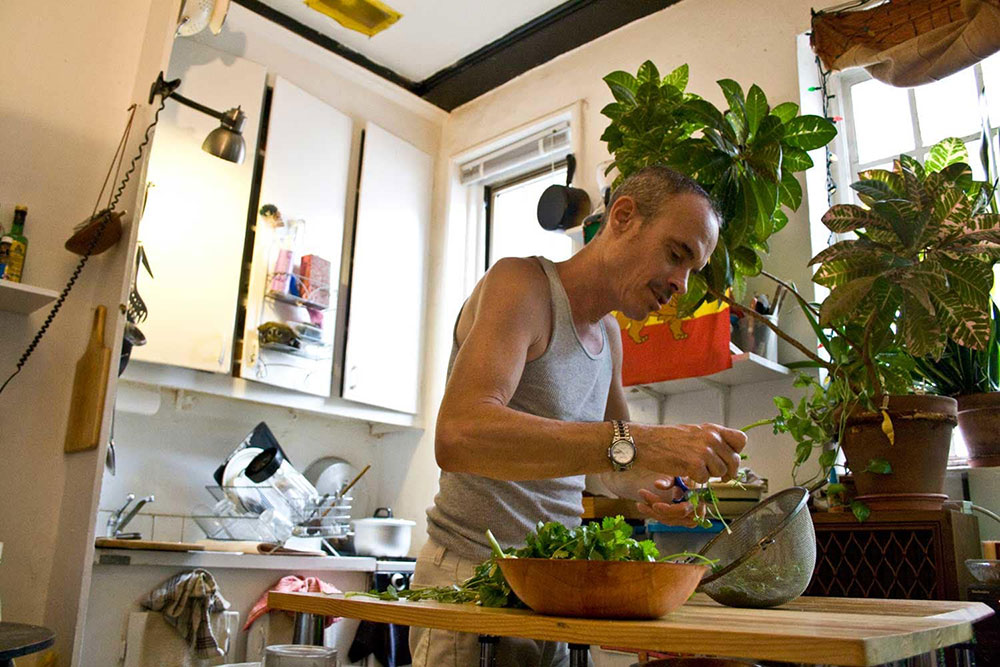I love a lot of things in life. Music is definitely numero uno in my book. Most of my days and nights are filled with it. Life revolves around it and would be pretty damn empty without it. Food is a close second. Not just because life would be impossible sans food. I just really love to eat. And cook—according to my girl and the guests we’ve had over for dinner, I do a pretty swell job at it.
Thanks to pal Dennis “Citizen” Kane, I discovered that Salvatore Principato (simply Sal P to his chums) is an avid and highly regarded vegan cook. I knew Salvatore Principato as the singer and percussionist of seminal post-punk/post-disco band Liquid Liquid, but a cook and damn good one too? Awesome. After gaining this nugget of info, I jumped at the chance to give some shine to a craft most people don’t know Sal P. has mastered. If you haven’t heard “Cavern” or “Bellhead” or “Optimo” (three mighty Liquid Liquid tunes), pause here for a moment, do yourself a favor and Google them. You’ll probably recognize at least one—even if you’re not familiar with the band. Grandmaster Flash borrowed the bassline from “Cavern” for his rap classic “White Lines (Don’t Do It).” The DJ duo of JD Twitch and JG Wilkes (known together as Optimo—two of my favorite DJs, btw) love the Liquid Liquid song so damn much they not only DJ and produce under that moniker, they even went as far as naming their Glasgow-based club after the tune. Or perhaps you’ve heard of them because James Murphy asked Liquid Liquid to open for LCD Soundsystem’s last show ever. Murphy has cited his influences as Liquid Liquid, Talking Heads, The Fall, Siouxsie and the Banshees, The Velvet Underground, David Bowie, and Daft Punk. An impressive peerage. You can peep a video of the band performing “Bellhead” at the LCD show linked below. To say that Liquid Liquid’s music has had a lasting and far-reaching impact would be an understatement. You’re not going to walk into a record store and find an original Liquid Liquid song on vinyl—if you do, run out and buy a lottery ticket. However, in 2008, Domino Records released a reissue of Liquid Liquid’s first three records along with previously unreleased bonus tracks in a newly designed package.
Back to the topic at hand… food. After a few phone calls and emails, Sal accepted my request: hit the Union SQ Greenmarket in Manhattan and cook me a dish. I assume, at this point, you’ve heard a bit of his music; now without further ado, let’s get to know the man, the myth… the cook.
The following words are 100% Salvatore Principato. Sal is accompanied by his good friend and photographer, Ruth Bartlet.
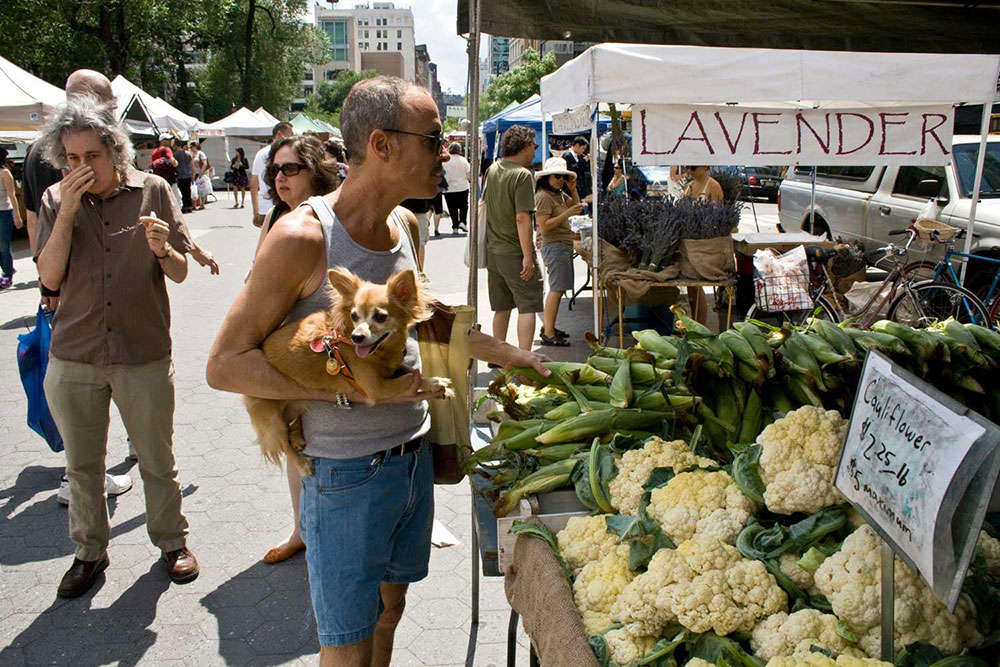
Almond cheese ravioli with a sauce made from farmer’s market tomatoes? Tabouleh salad with hummus? Summer pizza with pesto, fresh corn, and tomatoes? Roasted summer vegetables with saffron and Cous Cous?
These were some of the menu options I contemplated as I headed out to the Union SQ Greenmarket in Manhattan. What’s so great about this time of year (July through October) is that there is a farmers market happening nearly every day somewhere in New York City.
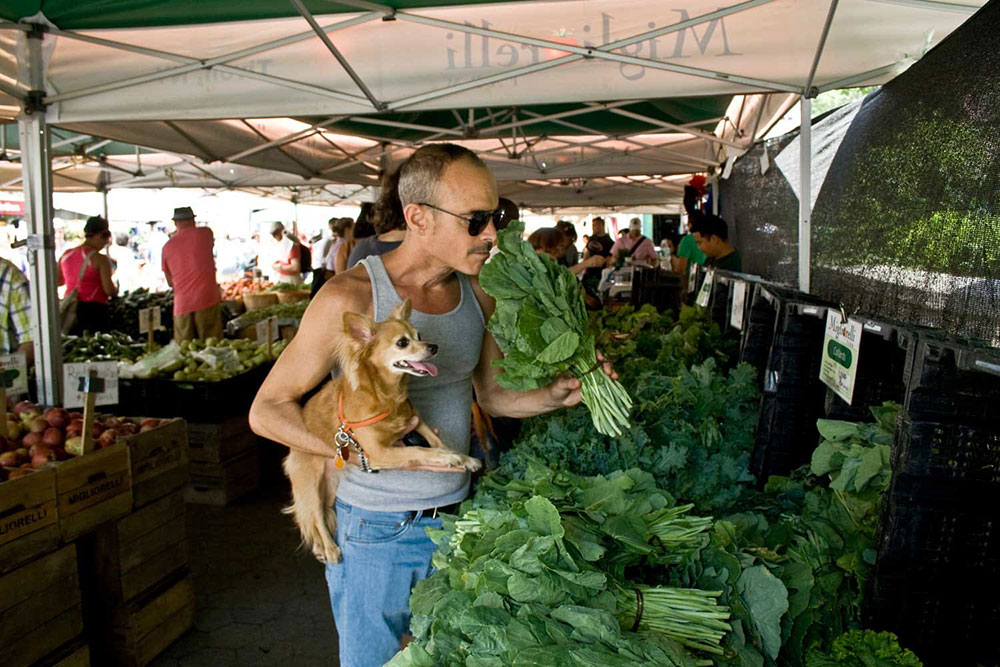
Our Greenmarkets sell only fruits, grains, and vegetables (as well as cheese, fish, meats, and bread) that are grown within 100 miles of New York City therefore I can buy fresh produce that’s harvested ripe and make use of it before it even needs to be refrigerated guaranteeing maximum taste and nutrition.
Accompanied by photographer and good friend Ruth Bartlett who was visiting from London and my longhaired Chihuahua “carrots” we picked our way through the Union SQ Market on a sultry Friday afternoon.
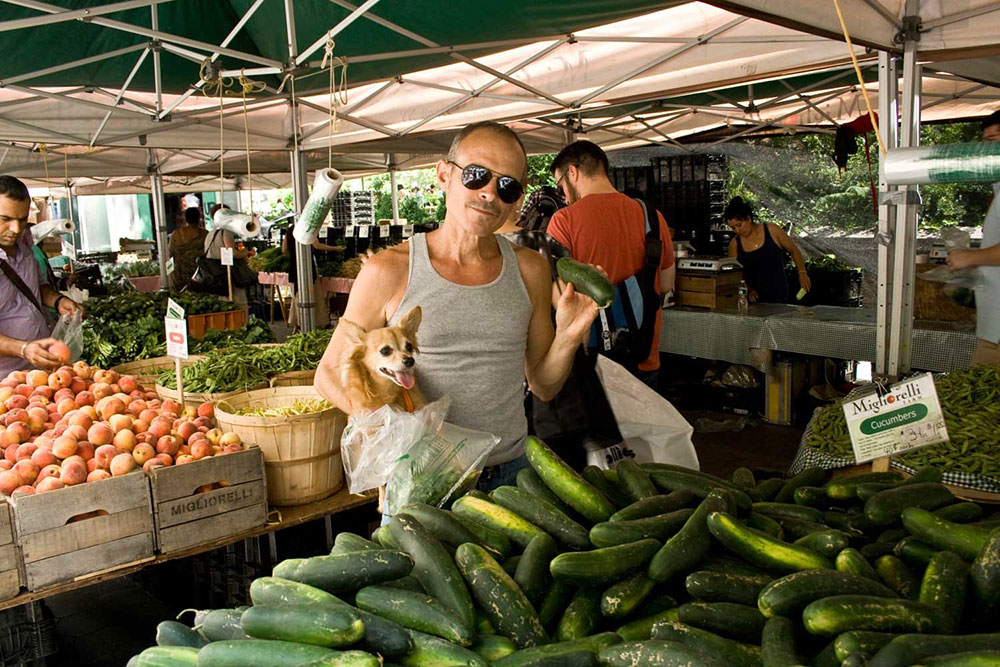
Vision of ratatouilles, salads, and sautéed greens passed through my brain as I visited my tried and true produce stands. The market, like many other quality purveyors, can be quite expensive if you don’t shop smart. And prices vary significantly so along with choosing items that are well into their season I familiarize myself with the prices and quality of each seller.
After surveying what was available, I decided I’d make some Tabouleh salad along with some Tempeh I had at home for which I’d create a homemade BBQ sauce. (Tempeh is a traditional soy product originally from Indonesia made by a natural culturing and controlled fermentation process that binds soybeans into a cake form.)
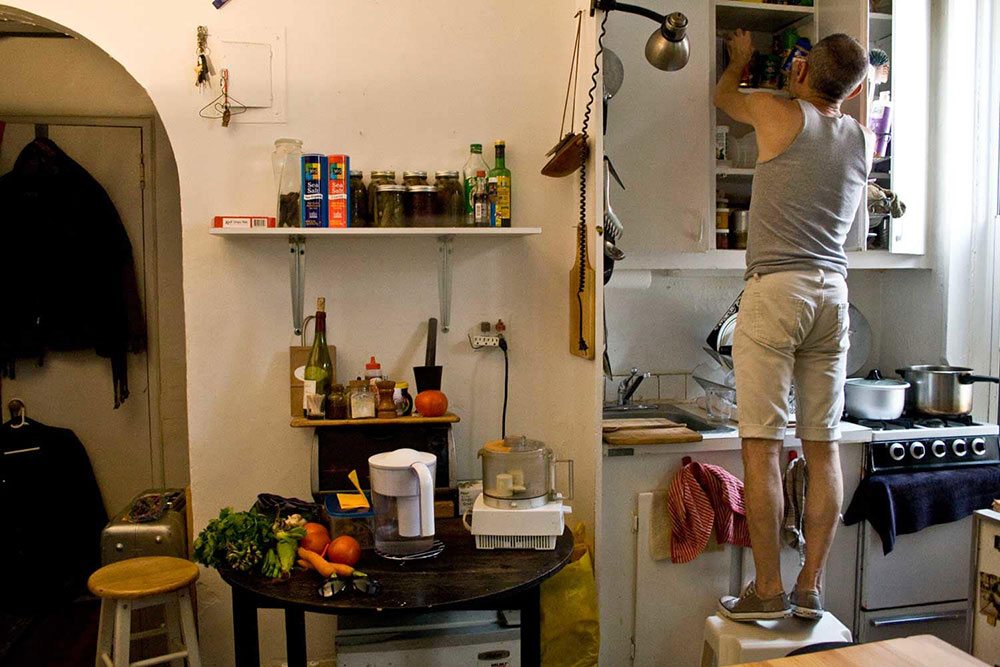
Tomatoes, fresh garlic, red scallions, and hot chilies for the BBQ sauce and cilantro/coriander, cucumbers, more tomatoes, sweet peppers, and carrots for the Tabouleh (I often use mint but none was to be found that day.)
Tabouleh is traditionally made with bulgur (cracked wheat), which is what I used for this batch. Occasionally I substitute Quinoa, which is a very tasty alternative. I utilize my rice cooker to prepare most grains though I rarely use measurements when I cook—I do have relative proportions. In this case, it’s two parts water to one part bulgur. Along with a dash of salt. It doesn’t take very long to cook bulgur and you can even skip the heating part if you want by soaking the wheat in cold water for a few hours.
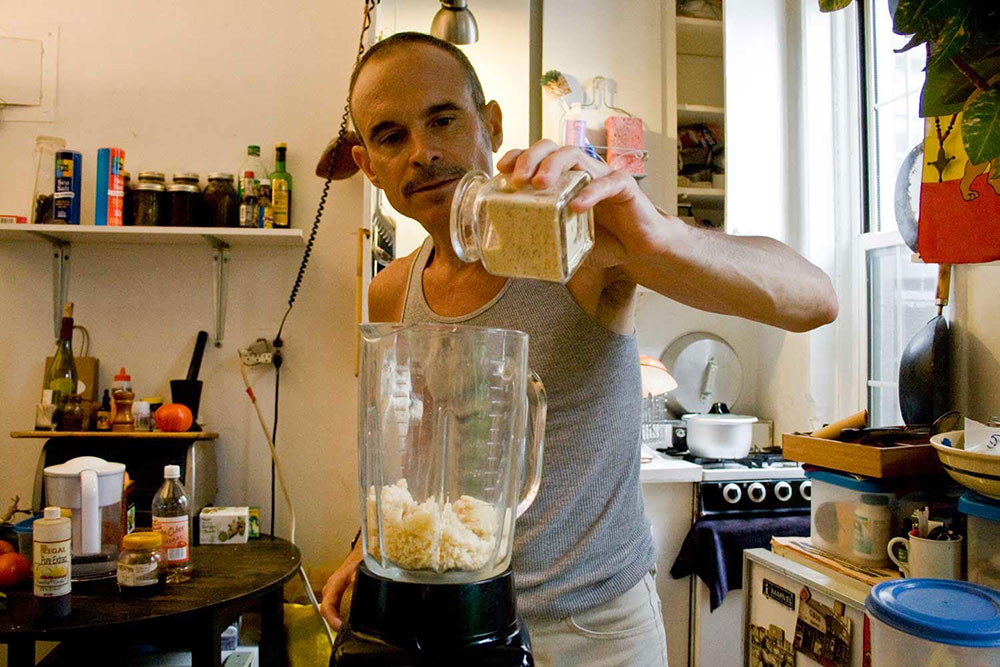
Along with taking photos, Ruth helped me chop, and chopped we did.
Some of my most essential kitchen tools (besides a sharp knife and a wood cutting board) are my blender, food processor, pressure cooker, wok, and, of course, the aforementioned rice cooker. No need for the pressure cooker in this round of cooking, but in general, they are a dream in food preparation. You can prepare many foods in a 1/3 the time using one—potatoes, beans, stews, soups, homemade Seitan…you name it. Throw away the goddamn microwave and get yourself a stainless steel pressure cooker.
When I use beans in a recipe (chickpeas, pinto, black, et cetera), I soak the dried beans overnight and then pressure cook them for 20-30 minutes. But, if I forget to soak, I can use my pressure cooker. And in an hour with lots of water that’s lightly salted, you can have lovely, flavorful legumes to use any which way you choose. Also, I save garlic tips, onion skins, stalks from greens, carrot tops, and the like in a plastic container. After accumulating a certain amount, I’ll rinse the scraps thoroughly and then cook with water in my pressure cooker, creating a versatile vegetable stock that I filter through a strainer.
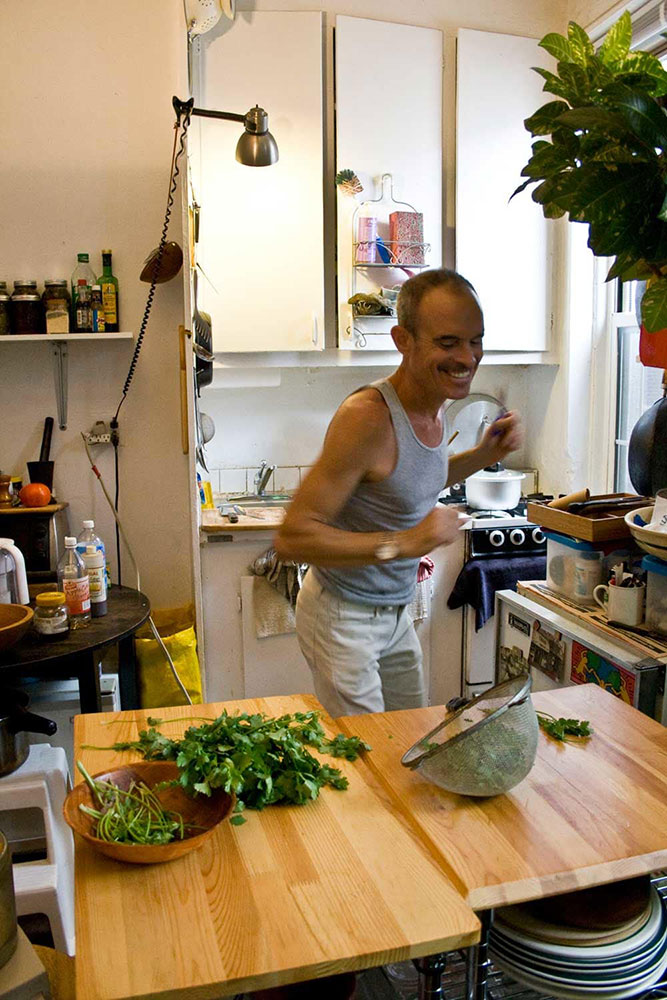
Putting my food processor to use I chopped the cilantro/coriander, scallions, and some carrots while dicing peppers, tomatoes, and cucumber—all of which I added to the bulgur wheat which was cooled and placed in a bowl, mixed together then doused generously with extra virgin olive oil. I then squeezed the juice of two-three lemons and added a touch of coarse sea salt and freshly ground black pepper for the finish.
At this point in the process, I took the time to clean up a bit. It’s fairly essential to the overall by not making a mess enjoyment of the meal that there isn’t a huge mess to be cleaned up afterward and that happens by cleaning up as you go. It’s the worst to prepare and enjoy this awesome, relaxing meal and have a pile of pots, bowls and utensils to deal with as well as the dishes and glasses you used. You say you’ll do the dishes in the morning? That’s even worse as the memory of the meal starts to fade it becomes pure, disconnected drudgery to clean up.
It is also important if you’re serious about preparing your meals, to plan ahead so you don’t end up with simplistic, cooked-in-a-rush food. In this case, since ravioli with homemade almond cheese was an option, I had almonds soaking, so I figured that since I wasn’t making hummus, which I usually top my Tabouleh with, I’ll make the almond cheese which is soft and has a similar consistency.
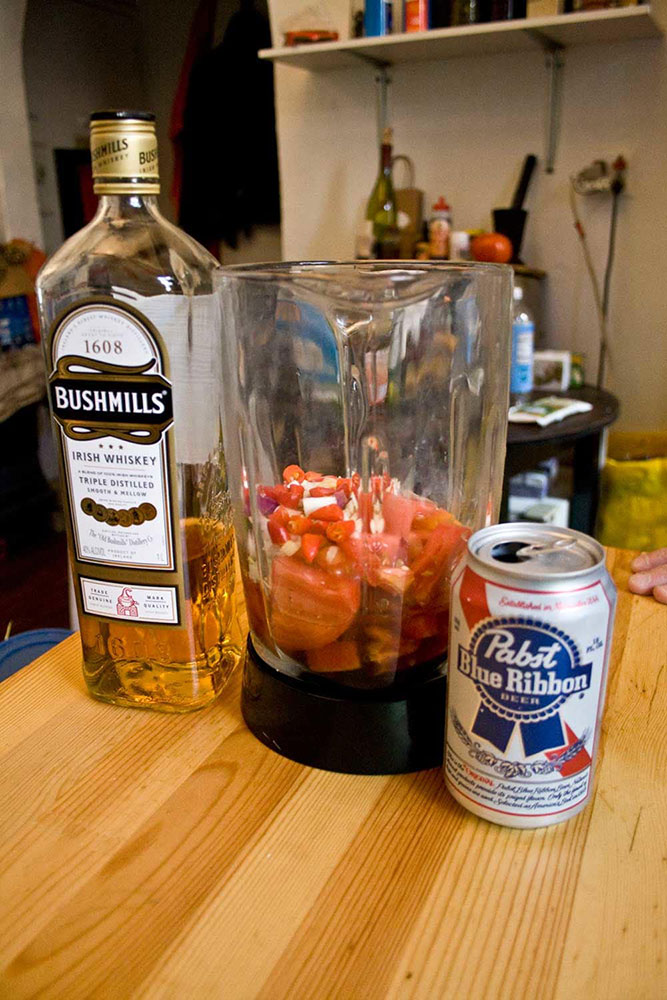
I started by taking the skin off the nuts and after a few hours soaking in water. It’s a fairly easy operation simply by squeezing between thumb and forefinger the skin comes right off to be discarded and once more I used the trusted food processor to pulverize the almonds. In most cases, you can use a blender where a food processor is called for but with a blender, you have to add a certain amount of liquid, which doesn’t always suit what you’re trying to make. For this particular recipe, I employed both because in order to achieve a really smooth consistency you gotta use a blender.
I place the now pulverized almonds into the blender adding a little neutral oil (in this case canola), a clove of garlic, a touch of nutritional yeast, a couple of drips of vanilla extract as well as a drizzle of molasses sea salt, black pepper and a little lemon juice giving all that a whirl. Finally, I added a small amount of Xanthan Gum, which is a binding agent derived from bacteria and glucose used in many salad dressings and sauces. The useful thing about it is that unlike various starches it doesn’t have to be heated in order for its thickening properties to be activated. Arrowroot or tapioca starch can be used instead, but then the mixture would have to be warmed and then cooled.
I poured the puree into a bowl and placed it in my freezer for a short while to further shape and bind it.
Moving on to the protein portion of the meal the first step was to put together an appropriate BBQ sauce to use with the tempeh.
Into the blender, I put a couple of chopped tomatoes and chilies. Added a splash of whiskey (any ole’ brand will do) a pour of apple cider vinegar chopped garlic and scallions, some molasses along with liquid smoke mustard powder, salt, and black pepper, and anything else one might fancy can work in this recipe. If you’re actually barbequing or baking in an oven, then add ¼-cup oil (a splash of sesame oil is nice), but since I was frying the tempeh, adding that extra fat to the sauce was unnecessary. I sliced the tempeh into thick rectangular strips. While in the wok, I heated a fair amount of canola oil (enough to cover each strip halfway) and proceeded to brown the tempeh on both sides removing each strip when complete.
Draining the excess oil from the wok but leaving a trace amount to integrate into the BBQ sauce, I poured a cup of sauce into the sizzling wok and after reducing the liquid just a bit, I added the fried tempeh back into the mixture, stirring to coat each strip thoroughly then lowering the flame and letting it simmer until the sauce caramelizes onto the tempeh. At this point, you can add a little more sauce to make it wetter or just let it be
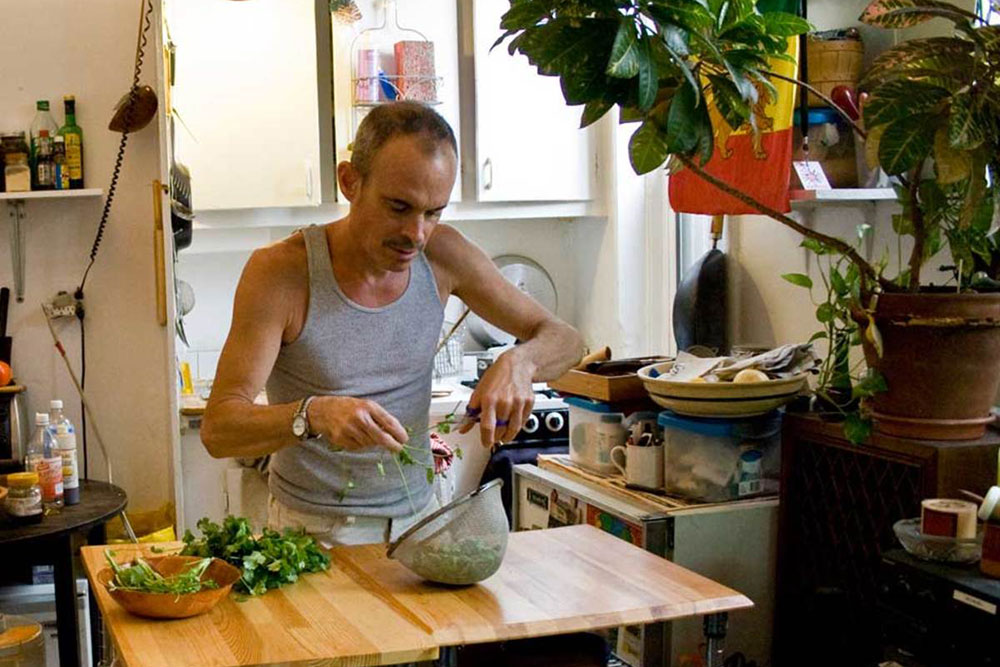
Time to Eat.
One of the great things about preparing your own food is that by the time the meal is ready to be served you’re not feeling desperate, starved, or bored—there’s a level of satiation that occurs during the preparation therefore, you approach your plate with a certain calm and easy appreciation.
Presentation, of course, is an important aspect of the enjoyment, and wouldn’t you know Ruth threw down the gauntlet saying “you fix your plate and I’ll do mine” she of restaurant experience me of dinner orientation and you can tell.

To explain my fascination and obsession with the process of shopping, preparing, and consuming the meals that nourish me is probably beyond my level of self-awareness. But in general, I embrace all the things that I enjoy in particular and are accessible to me. In general, I find preparing my food very empowering, even cleaning up after myself is somehow an affirmation. Take care of the basics and all else shall follow. It’s that and also a simple appreciation of sensory delight smell, taste, and feel—aside from the politics of what and how we eat. I find it curiously comforting to talk about what people are eating and how they came to eat it… did you enjoy it? As someone who leans toward the vegan persuasion on a personal level, I won’t hold your culinary orientation against you, but…be mindful that in the end, it’s not just about what you like, but what likes you.
